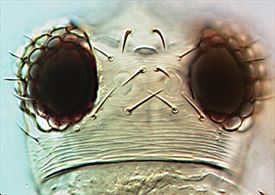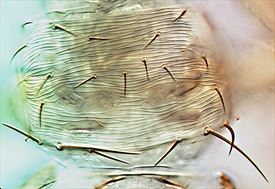Distinguishing features
Both sexes fully winged. Female mainly yellow, with dark fore wings and cuticular markings; antennal segment I pale, II variable from pale brown to dark, III–VIII mainly dark brown; head faintly shaded in front of ocelli; thorax with variable pale markings; tergites II–VIII with dark antecostal ridge variably shaded both in front and behind, and with a dark area laterally; sternites III–VII with a dark transverse line and a variable dark mark laterally; legs yellow with brown markings; all major setae dark, Head broad; vertex with transverse lines; ocellar setae III close together, just in front of posterior ocelli; mouth cone long but rounded. Antennal segment II with 1 dorsal seta exceptionally stout; segments III and IV each with a long, forked sense cone. Pronotum with striae not close together; posteromarginal setae independently variable. Metanotum weakly reticulate medially, with median setae close to anterior margin. Fore wing with apices of posteromarginal cilia slightly wavy; first vein usually with 3+3+1+1+1 setae; second vein usually with 4 widely spaced setae; clavus with 4 marginal and 1 discal seta. Tergites II–VII each with 3 pairs of discal setae on field of microtrichia anterior to posteroangular seta; tergites VIII and IX without microtrichia medially. Sternites with microtrichia laterally, but scarcely any mesad of marginal setae S2 .
Male similar to female in colour and structure, but smaller. Tergite IX with 4 pairs of dorsal setae arranged in a curved, transverse row; the paired drepanae extend to body apex.
Related species
This species is unusual in having the pronotal striae rather wider apart and the major pair of pronotal posteroangular setae relatively longer than most species of this genus. It is most closely similar to certain species from eastern Australia, particularly one that is common on tree ferns (Hoddle & Mound, 2010).
Biological data
Feeding and breeding on young leaves, the host plants of this native species remain unclear, but it has been collected most commonly from native species of Rubus [Rosaceae] and Weinmannia [Cunoniaceae].
Distribution data
Known only from New Zealand (AK, CL, BP, GB, TO, RI / NN, SD, BR).
Family name
THRIPIDAE, THRIPINAE
Species name
Scirtothrips pan Mound & Walker
Original name and synonyms
Scirtothrips pan Mound & Walker, 1982: 46
References
Hoddle MS & Mound LA (2003) The genus Scirtothrips in Australia (Insecta, Thysanoptera, Thripidae). Zootaxa 268: 1–40.
Mound LA & Walker AK (1982) Terebrantia (Insecta: Thysanoptera). Fauna of New Zealand 1: 1–113.



